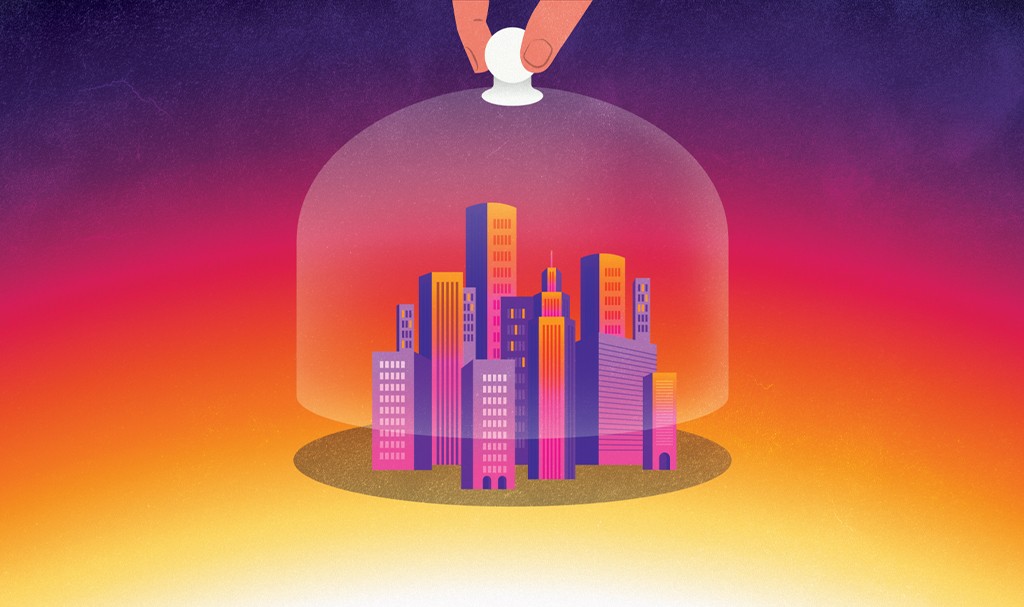
AsianScientist (May. 10, 2024) – In 1833, a pharmacist-turned-amateur meteorologist named Luke Howard first observed a phenomenon which would become a hot research topic in the following decades. He discovered that the temperatures he recorded on the outskirts of London were lower than the temperatures recorded by The Royal Society, England’s premier scientific academy, within the city. In the same year, Howard published his seminal work The Climate of London, in which he noted that the mean temperature between between 1831 and 1879 across London was about 9.17 degrees Celsius, but in the denser parts of the metropolis, the temperature was slightly higher: 10.28 degrees.
About a century later, other scientists revisited and confirmed Howard’s insights that denser parts of cities are hotter than the sparsely built parts, a phenomenon that researchers call urban heat islands (UHIs). Now, with the growing concern about global warming, more research is being done to better understand and tackle UHIs.
A 2022 study conducted by the European Commission’s Joint Study Centre stated that cities are often 10–15 degrees warmer than the countryside due to high levels of industrialization, which often manifest in high-rise buildings, concrete roads and inadequate green spaces. These developments contribute to trapping heat, resulting in higher land surface temperatures, especially during the summer, in dense areas of cities.
Scientists estimate that as the Earth continues to warm, it will likely lead to an increase in the UHI effect in cities. Data from Meteorological Service Singapore, for example, shows that temperatures in the country have risen by an average of 0.25 degrees per decade since 1948. Meanwhile, in Hong Kong, the annual mean temperature has risen by 0.13 degrees every decade from 1885 to 2019. This rate further increased to 0.21 degrees in the latter half of the 20th century, according to the Hong Kong Observatory.
By 2050, close to seven billion people are estimated to live in cities. Add to that another projection: extreme weather events becoming more intense and frequent with global warming. For example, in April 2023, Southeast Asia experienced a record-breaking heatwave that once happened 200 years ago. This means that as more people live in cities, an increasing number of people will be exposed to much hotter temperatures than those living in the countryside. Moreover, extreme heat poses a serious threat to human health: Not only does it increase the risk of heat stroke, hypertension and asthma, but extreme heat also aggravates preexisting illnesses like diabetes.
So, what can be done?
REDUCING HEAT ABSORPTION
The built environment is one of the biggest factors contributing to UHIs. Pavements and roofs roughly account for 60 percent of urban surfaces and are among the main culprits behind urban heat entrapment. For instance, a study published in Ecotoxicology and Environmental Safety in 2022 revealed that the construction of the Beijing Daxing International Airport in China had increased the UHI ratio index by 35 percent, suggesting that large-scale constructions aggravate thermal pollution.
One way to mitigate these impacts is to use building materials such as white roofs and light-colored stones that reflect heat energy back into the atmosphere. According to Chiu Wen Tung, group director of research and development at Singapore’s Urban Redevelopment Authority (URA), using cool materials has helped reduce ambient temperatures in high-rise public housing apartment blocks by up to 2 degrees, prompting the Singapore government to continue exploring its use in other community spaces.
Transforming concrete roads into semi-permeable ones is another measure that can help roads absorb less heat. In 2014, China’s government piloted a project that would transform cities into “sponges” to address flooding issues. Among other steps, this meant that hard surfaces such as roads and pavements had to be transformed into porous surfaces that can absorb, purify and store water that can be used later. In Wuhan city, one of the benefits of implementing these surfaces—in addition to reducing urban flooding—was cooler surroundings.
In a 2020 working paper presented by the Coalition for Urban Transitions, researchers at the University of Leeds revealed that this sponging initiative reduced the temperatures around Wuhan’s Yangtze River Park by more than 3 degrees. Another study from Guangzhou, published in 2019 in Building and Environment, showed that using porous bricks and concrete could reduce pavement surface temperatures by 12 degrees and 20 degrees respectively, while bringing down the surrounding air temperature by a degree.
GOING GREEN
Singapore is a veritable master at greening, which can effectively reduce temperatures in dense parts of cities. Known as the “garden city,” the country integrated environmental protection goals into its urban planning as early as the 1960s, enabling it to become one of the greenest cities in the world.
In 2005, Singapore introduced a green building certification system—the Green Mark Scheme (GMS). Developed by the country’s Building and Construction Authority, GMS provided a set of guidelines that promoted high-quality, safe and sustainable practices in building design and construction, aligned with Singapore’s tropical climate.
A 2022 paper in the International Journal of Environmental Research and Public Health, which studied the urban heat mitigation measures in Singapore, reported that commercial districts such as Marina Barrage and Newton exhibited the lowest percentage of temperature change, about 1.6 percent per year, from 2017 to 2019. Interestingly, these districts had approximately 57 percent more green spaces in comparison to non-commercial areas, where the temperature change was as high as 3 percent.
The size of the green areas also matters. After surveying 24 parks in Shanghai in 2015 and then again in 2020, a group of researchers found that increasing green spaces by about 50 hectares correspond with a reduction in land surface temperatures by 0.6 degrees.
HARNESSING WIND POWER
While greening is a viable solution, the degree of its effectiveness depends on the local climate. Cities with a dry climate benefit more from greening; on its own, it can significantly minimize the temperature difference between urban and rural areas. But in tropical climates, just greening may not do much to reduce the UHI effect. It needs to be combined with strategies that increase shade and improve airflow.
“Microclimatic factors can influence outdoor thermal comfort and heat stress levels. While air temperature is a crucial factor, other environmental factors such as humidity, wind speed and direct sunlight collectively impact the level of heat stress experienced by individuals,” Tung told Asian Scientist Magazine.
In Tokyo, the National Institute for Land and Infrastructure Management (NILM) conducted a study between 2004 and 2006 on the UHI problem. In collaboration with the Building Research Institute, Waseda University, Tokyo Metropolitan University and Nippon Institute of Technology, the researchers evaluated the potential of “wind paths” in mitigating urban heat stress in dense parts of the city.
Known as kaze-no-michi, these wind paths are based on a German ecological city planning approach that allows cool air to flow into the city from an outside source. Since central Tokyo is in front of Tokyo Bay, the ocean became the cooling source. After running simulations that involved razing buildings and other infrastructures acting as walls against the sea breeze, the researchers found that the breeze traveling from Tokyo Bay through kaze-no-michi could cool a length of 1.5 kilometers inside Tokyo. Following the study, the local government demolished one of the blockade buildings, opening up a wind path into the city’s inner and dense areas.
ACCESS ISSUES
Tackling UHI would also require urban planners and governments in Asia to be more inclusive in their approach. “The urban heat island effect is not just an urban planning problem, it’s also a socioeconomic problem,” Leanardo Poco, an architect and urban planner based in the Philippines, told Asian Scientist Magazine. Each city in the Philippines has its own set of regulations when it comes to land development, with the cost often shouldered by the private sector. While land developers try to build infrastructures using sustainable techniques, the reality is that these places are not always accessible to the communities most vulnerable to heat hazards.
“Without a central master plan, the best we get are open spaces within villages and gated subdivisions that have small parks and courtyards. So, part of the urban heat island question is, where are the open spaces—and for whom are they built?” Poco said.
A 2020 study in Nature Communications assessed the health risks of extreme heat in the Philippines. It found that the most vulnerable cities in the country were those with a high poverty incidence rate, a high proportion of young and old people, and a low capacity to cope and adapt. Such studies are helping build a consensus that the initiatives to reduce UHIs in cities should include strategies that lower the overall heat risk to vulnerable groups.
In 2023, the Heat Resilience and Performance Centre (HRPC) was set up in Singapore to lead Southeast Asia’s efforts in addressing the impacts of rising heat in the region. Housed at the National University of Singapore, HRPC will focus on developing a heat health readiness system that uses smart sensors to identify individuals at risk of heat stress and give personalized recommendations on interventions based on one’s health, activity level, attire and surroundings.
While some governments in Asia are actively working toward mitigating the effects of UHI, Poco said that local communities also need to be encouraged to create changes where they can. One way to do that is through tactical urbanism—a quick, low-cost and action-oriented approach to creating meaningful civic changes in neighborhoods and cities. For example, if people have a grill fence, they can hang plants on it, which would give them more privacy while increasing the biomass to reduce thermal impact, said Poco. Such actions may seem tiny but when done at a large scale, they add up and complement systems-level initiatives by the government institutions.
Poco said, “Urban heat islands are just the canary in the coal mine. Unless we change our built environment, more people will get sick.”
—
This article was first published in the print version of Asian Scientist Magazine, January 2024.
Click here to subscribe to Asian Scientist Magazine in print.
Copyright: Asian Scientist Magazine.
Disclaimer: This article does not necessarily reflect the views of AsianScientist or its staff.












